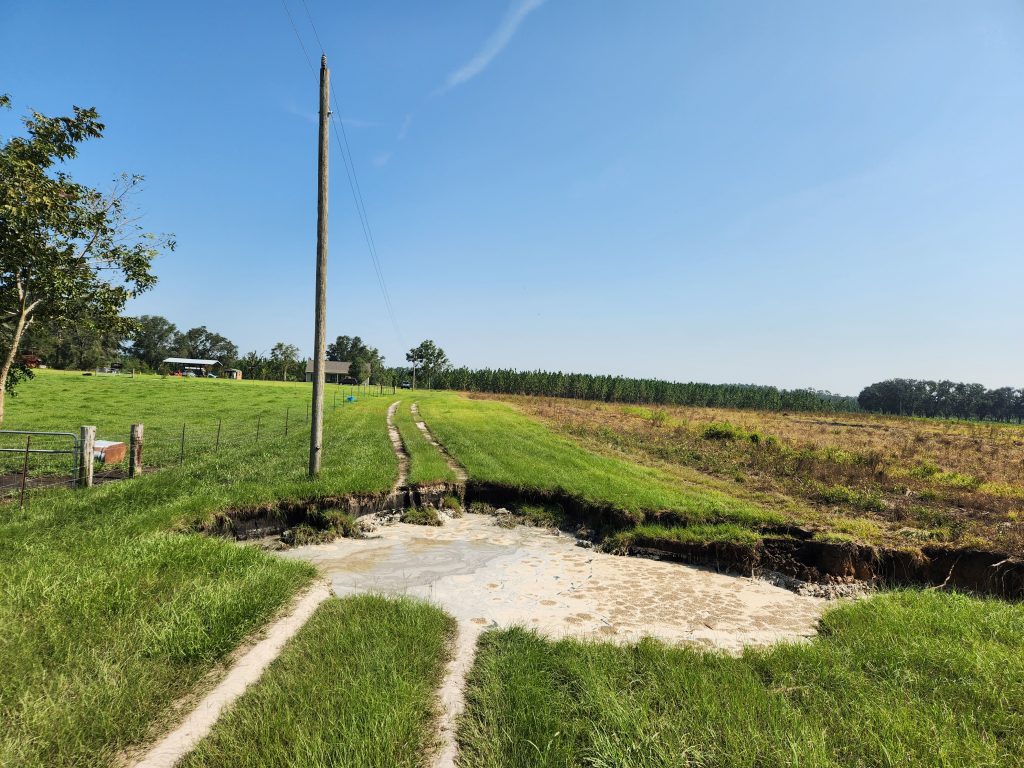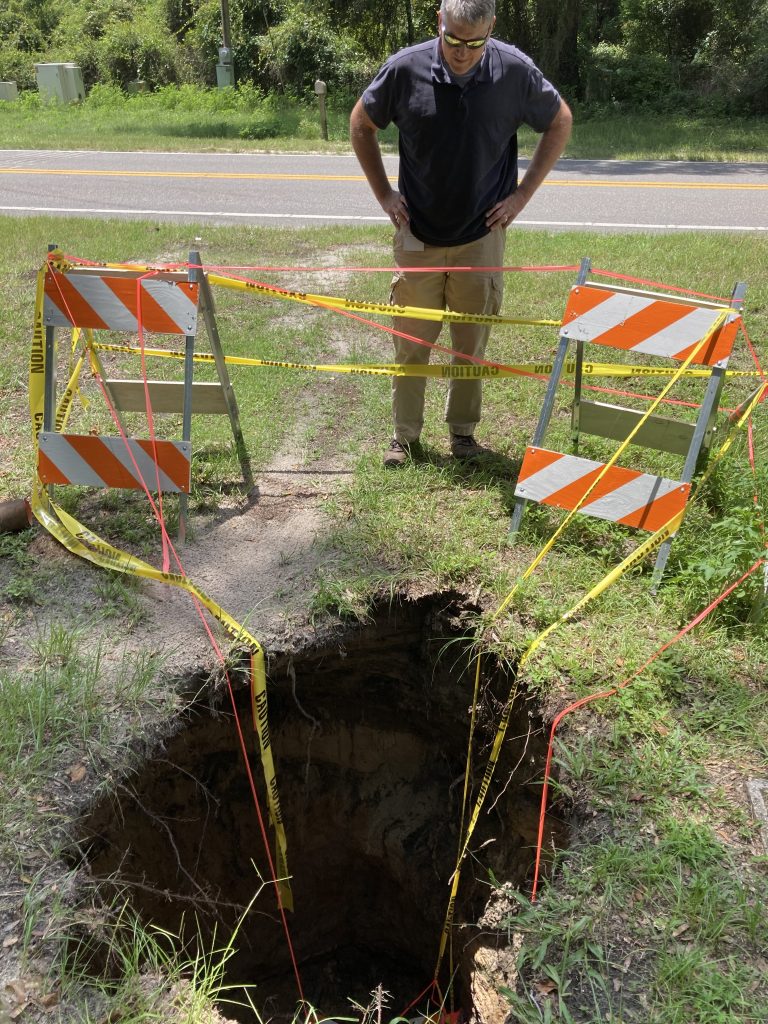
This sinkhole opened up after Hurricane Debby made landfall in Florida’s Big Bend region on August 5, 2024. Image source: Suwannee River Water Management District.
Sinkholes are a natural part of Florida’s landscape, especially in areas where limestone lies close to the surface. If a sinkhole appears on your property, knowing how to respond is key. This article outlines important first steps, available resources, and expert contacts to help you assess the situation and determine what to do.
How do sinkholes form?
Sinkholes form when surface sediments collapse into empty spaces, or cavities, within the limestone bedrock beneath the ground. These cavities develop over time as slightly acidic groundwater slowly dissolves the limestone. When a cavity becomes too large to support the weight of the ground above it, a sudden collapse can occur, creating a noticeable hole at the surface. In some cases, sinkholes can form gradually as sediments slowly settle into cavities over long periods of time, resulting in shallow, bowl-shaped depressions without a sudden collapse.
Limestone underlies our entire state but there are regions where the risk of sinkholes is higher, such as where the limestone is closer to the surface. Although cavities and voids are a feature of carbonate rocks like limestone, few collapse and directly impact roads or buildings.
Where can you find help if you have a sinkhole on your property?
The Florida Geological Survey (FGS), has a Sinkhole Helpline (850 245-2118) as well as a sinkhole website and extensive Sinkhole FAQ to answer residents’ questions. You can speak with someone on the helpline for guidance about what to do (you may not need to do anything) and they can help clarify information found in the FAQ. The FGS also has a leaflet available, A Homeowner’s Guide to Sinkholes in Florida.
You can also contact your Water Management District for guidance. In our region, that would either be the Northwest Florida Water Management District (850 539-5999) if you live in Escambia County to western Jefferson County, or the Suwannee River Water Management District (386 362-1001) if you live in North Central FL, including eastern Jefferson County (Suwannee River WM District Boundary Map).
Here are a few important tips to keep in mind, summarized from the Florida Geological Survey Sinkhole FAQ. Much more detailed information is found on the website. Call the sinkhole helpline or your Water Management District for further clarification on steps to take.
- Call your local law enforcement agency if there is any risk of physical harm.
- For sinkholes under or near structures: Stay out of your house if you suspect the hole is causing or could cause any impact to the structure. In some counties, local government agencies, the sheriff’s office or emergency management office may offer help when a home is endangered.
- Contact your property insurance to see if they cover assessment and repair of damage caused to structures. It’s recommended to mark the hole’s approximate boundaries and document its size by taking photographs and monitoring changes. Do this from a safe distance. Keep children and pets away.
- For sinkholes in your yard, small holes can often be filled with clean sand or soil.
- On large properties, sinkholes that are not actively developing and are not affecting a structure can usually be left alone. If there’s a risk of people or animals falling in, fence or cordon off the sinkhole or you can usually fill the hole with clayey sand (which is preferred) although clean fill material can also be used. Don’t throw anything into a sinkhole or use any fill material that can decompose or leach toxins into groundwater. Call the Sinkhole Helpline for further clarification (850 245-2118).
- Although no permit is usually needed to fill a new sinkhole, sinkholes in wetland areas or those that may change water flow or add to groundwater pollution if filled may need an environmental resources permit (ERP) before filling. Contact your Water Management District or FL Department of Environmental Protection (FDEP) District Office for guidance.
- Keep in mind that other factors besides sinkholes can cause settling on the land surface. These include decomposing stumps, compressed or decomposing garbage and other debris, collapsed or broken sewer pipes and septic systems, soil that wasn’t compacted properly after excavation was completed, among others.
Additional information:
For insurance questions: Dept. of Financial Services – Division of Consumer Services
For information about your rights as a tenant or landlord review the Dept of Agriculture & Consumer Services’ Landlord and Tenet Law
- What to Do if a Sinkhole Opens on Your Property? - June 6, 2025
- Workshop on Private Well and Septic System Basics - October 18, 2024
- Septic system maintenance after a flood - June 7, 2024

